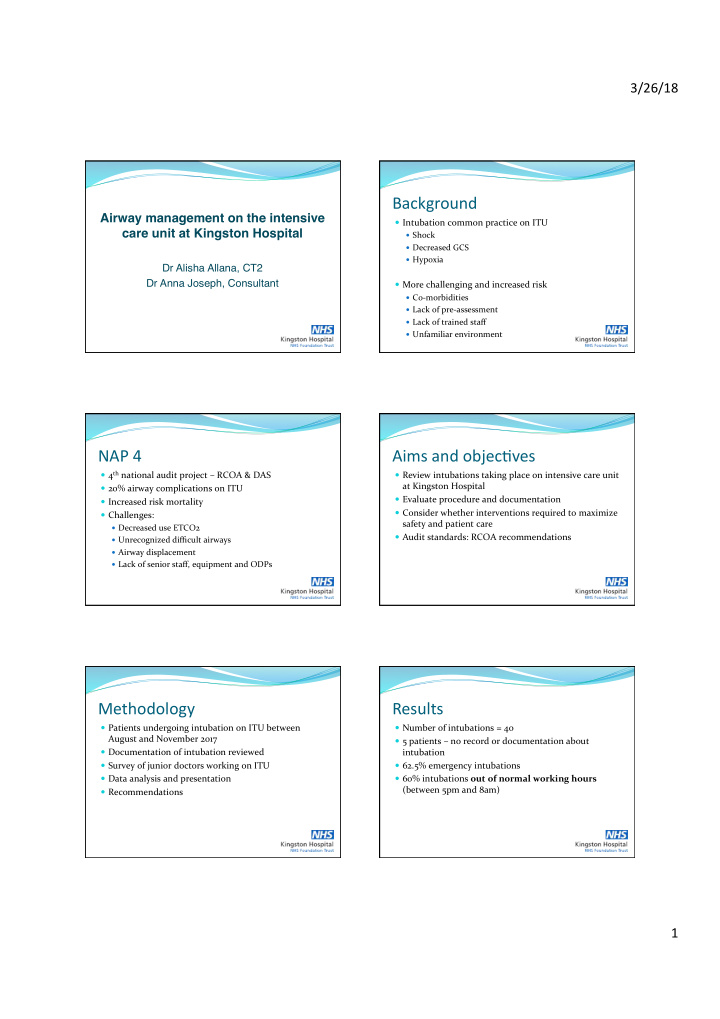



3/26/18 ¡ Background ¡ Airway management on the intensive Intubation ¡common ¡practice ¡on ¡ITU ¡ care unit at Kingston Hospital � Shock ¡ Decreased ¡GCS ¡ Hypoxia ¡ Dr Alisha Allana, CT2 � Dr Anna Joseph, Consultant � More ¡challenging ¡and ¡increased ¡risk ¡ Co-‑morbidities ¡ Lack ¡of ¡pre-‑assessment ¡ Lack ¡of ¡trained ¡staff ¡ Unfamiliar ¡environment ¡ NAP ¡4 ¡ Aims ¡and ¡objec<ves ¡ 4 th ¡national ¡audit ¡project ¡– ¡RCOA ¡& ¡DAS ¡ Review ¡intubations ¡taking ¡place ¡on ¡intensive ¡care ¡unit ¡ at ¡Kingston ¡Hospital ¡ 20% ¡airway ¡complications ¡on ¡ITU ¡ Evaluate ¡procedure ¡and ¡documentation ¡ Increased ¡risk ¡mortality ¡ Consider ¡whether ¡interventions ¡required ¡to ¡maximize ¡ Challenges: ¡ safety ¡and ¡patient ¡care ¡ Decreased ¡use ¡ETCO2 ¡ Audit ¡standards: ¡RCOA ¡recommendations ¡ Unrecognized ¡difficult ¡airways ¡ Airway ¡displacement ¡ Lack ¡of ¡senior ¡staff, ¡equipment ¡and ¡ODPs ¡ Methodology ¡ Results ¡ ¡ Patients ¡undergoing ¡intubation ¡on ¡ITU ¡between ¡ Number ¡of ¡intubations ¡= ¡40 ¡ August ¡and ¡November ¡2017 ¡ 5 ¡patients ¡– ¡no ¡record ¡or ¡documentation ¡about ¡ Documentation ¡of ¡intubation ¡reviewed ¡ intubation ¡ Survey ¡of ¡junior ¡doctors ¡working ¡on ¡ITU ¡ 62.5% ¡emergency ¡intubations ¡ Data ¡analysis ¡and ¡presentation ¡ 60% ¡intubations ¡ out ¡of ¡normal ¡working ¡hours ¡ (between ¡5pm ¡and ¡8am) ¡ Recommendations ¡ ¡ 1 ¡
3/26/18 ¡ Results ¡ Results ¡ ¡ Most ¡senior ¡member ¡of ¡staff ¡present ¡ 72.5% ¡intubations ¡>1 ¡doctor ¡present ¡ No ¡documentation ¡about ¡nursing ¡staff ¡ No ¡documentation ¡about ¡NG ¡feed ¡ 42.5% ¡-‑ ¡cricoid ¡pressure ¡ 60% ¡of ¡patients ¡pre-‑oxygenated ¡ ¡ ¡45% ¡ ¡ ¡23% ¡ Airway ¡management ¡ Results: ¡complica<ons ¡ 4 ¡patients ¡– ¡GlideScope ¡ 16 ¡patients ¡ ¡post ¡intubation ¡CXR ¡ 5 ¡patients ¡– ¡Bougie ¡ Little ¡documentation ¡about ¡use ¡of ¡airway ¡devices ¡ 22.5% ¡intubations ¡ ¡complications ¡ 2 ¡cardiac ¡arrests ¡ 4 ¡cases ¡extreme ¡hypoxia ¡ 2 ¡arrythmias ¡requiring ¡shock ¡ 1 ¡pneumothorax ¡ Results: ¡junior ¡doctor ¡survey ¡ I ¡am ¡familiar ¡ In ¡ITU, ¡it ¡is ¡not ¡my ¡ with ¡the ¡ practice ¡that ¡I ¡am ¡not ¡ environment ¡and ¡ “I ¡feel ¡confident ¡intubating ¡a ¡patient ¡in ¡theatres” ¡ support ¡in ¡ confident ¡with, ¡but ¡the ¡ theatres ¡ fact ¡that ¡the ¡environment ¡ “I ¡feel ¡confident ¡intubating ¡a ¡patient ¡on ¡ITU” ¡ is ¡unfamiliar ¡and ¡I ¡don’t ¡ know ¡how ¡to ¡use ¡certain ¡ equipment ¡ ¡ It ¡depends ¡on ¡the ¡patient, ¡the ¡ degree ¡of ¡urgency ¡and ¡who ¡I’ve ¡got ¡ to ¡help ¡me…positioning ¡is ¡ normally ¡easier ¡in ¡theatres ¡and ¡ ODPs ¡are ¡better ¡at ¡assisting ¡than ¡ ITU ¡nurses ¡ 2 ¡
3/26/18 ¡ Evalua<on ¡ Documenta<on ¡ Common ¡procedure ¡ 5 ¡patients ¡– ¡no ¡documentation ¡ Current ¡practice: ¡2 ¡airway ¡trolleys ¡and ¡GlideScope ¡ Detailed ¡info ¡about ¡drugs ¡and ¡grade ¡– ¡nil ¡else ¡ No ¡formal ¡teaching ¡or ¡training ¡for ¡doctors ¡or ¡nurses ¡ Key ¡for ¡future ¡care ¡ in ¡airway ¡management ¡ Provides ¡information ¡for ¡audit ¡and ¡research ¡ No ¡checklists ¡ Trainees ¡lack ¡confidence ¡intubating ¡patients ¡on ¡ITU ¡ Recommendation: ¡proforma ¡on ¡CRS ¡ Increased ¡stress ¡levels ¡ ¡ ¡Easy ¡to ¡navigate ¡ Decreased ¡leadership ¡ability ¡ ¡ ¡Efficient ¡entry ¡of ¡crucial ¡information ¡ ?Increased ¡risk ¡complications ¡ In ¡situ, ¡ Staff ¡ MDT ¡ simulation ¡ CT1 ¡(6m ¡anaesthetics ¡experience) ¡ ¡consultants ¡(airway ¡ training ¡ and ¡non ¡airway ¡trained) ¡ Consultant ¡present ¡for ¡50% ¡of ¡intubations ¡ 60% ¡out ¡of ¡normal ¡working ¡hours ¡ No ¡ODP ¡presence ¡ ¡ Recommendations: ¡ 1. ¡Intubation ¡checklist ¡ Increased ¡ Improved ¡ 2. ¡Multi-‑disciplinary ¡simulation: ¡on ¡ITU, ¡difficult ¡scenarios, ¡ confidence ¡ teamwork ¡and ¡ feedback ¡and ¡discussion. ¡Focus ¡on ¡human ¡and ¡clinical ¡ levels ¡(doctors ¡ communication ¡ factors ¡including ¡task ¡fixation ¡and ¡communication. ¡ and ¡nurses) ¡ Equipment ¡ 2 ¡airway ¡trolleys ¡ GlideScope ¡ Unfamiliarity ¡with ¡equipment ¡e.g. ¡bougie ¡vs ¡Stylet ¡ ?BURP, ¡cricoid ¡pressure ¡ 3 ¡
3/26/18 ¡ Higher ¡risk ¡pa<ents ¡ Critically ¡unwell, ¡higher ¡risk ¡hypotension/hypoxia ¡ post ¡intubation ¡ Lack ¡of ¡time ¡for ¡adequate ¡airway ¡assessment ¡or ¡ preparation ¡ May ¡not ¡be ¡fasted/decreased ¡gastric ¡emptying ¡ ¡ More ¡sensitive ¡to ¡side ¡effects ¡of ¡intubation ¡drugs ¡ Inadequate ¡pre-‑O2: ¡patient ¡co-‑morbidities/urgency ¡ ¡ Difficult ¡positioning/access ¡due ¡to ¡equipment ¡ Recommendations: ¡identify ¡high ¡risk ¡airways ¡ Conclusion ¡ References ¡ High ¡risk ¡procedure ¡in ¡high ¡risk ¡environment ¡ Cook ¡TM, ¡Woodall ¡N, ¡Harper ¡J, ¡Benger ¡J, ¡on ¡behalf ¡of ¡the ¡Fourth ¡ National ¡Audit ¡Project. ¡Major ¡complications ¡of ¡airway ¡management ¡in ¡ How ¡can ¡we ¡make ¡it ¡safer? ¡ the ¡UK: ¡results ¡of ¡the ¡Fourth ¡National ¡Audit ¡Project ¡of ¡the ¡Royal ¡ College ¡of ¡Anaesthetists ¡and ¡the ¡Difficult ¡Airway ¡Society. ¡Part ¡2: ¡ AAGBI, ¡DAS ¡and ¡Intensive ¡Care ¡Society ¡promote ¡ intensive ¡care ¡and ¡emergency ¡departments. ¡Br ¡J ¡Anaesth ¡2011; ¡106: ¡ 632-‑42. ¡ training, ¡education ¡and ¡checklists ¡ Divatia ¡JV, ¡Khan ¡PU, ¡Myatra ¡SN. ¡Tracheal ¡intubation ¡in ¡the ¡ICU: ¡Life ¡ saving ¡or ¡life ¡threatening? ¡Indian ¡J ¡Anaesth. ¡2011;55:470–5. ¡ Martin ¡LD, ¡Mhyre ¡JM, ¡Shanks ¡AM, ¡Tremper ¡KK, ¡Kheterpal ¡S. ¡3,423 ¡ emergency ¡tracheal ¡intubations ¡at ¡a ¡university ¡hospital: ¡Airway ¡ outcomes ¡and ¡complications. ¡Anesthesiology.2011;114:42–8. ¡ Mayo ¡PH, ¡Hegde ¡A, ¡Eisen ¡LA, ¡Kory ¡P, ¡Doelken ¡P. ¡A ¡program ¡to ¡improve ¡ the ¡quality ¡of ¡emergency ¡endotracheal ¡intubation. ¡J ¡Intensive ¡Care ¡ Med. ¡2011;26:50–6. ¡ ¡ 4 ¡
Recommend
More recommend